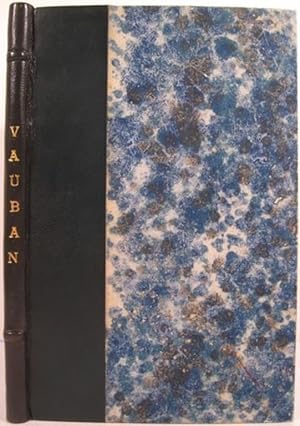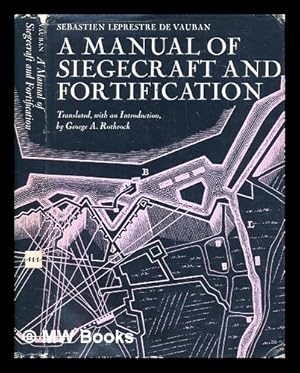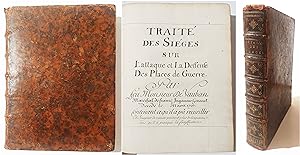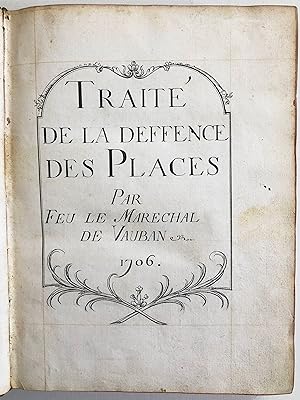VAUBAN, SEBASTIEN LE PRESTRE DE 1633 1707 (6 Ergebnisse)
Produktart
- Alle Produktarten
- Bücher (6)
- Magazine & Zeitschriften
- Comics
- Noten
- Kunst, Grafik & Poster
- Fotografien
- Karten
-
Manuskripte &
Papierantiquitäten
Zustand
- Alle
- Neu
- Antiquarisch/Gebraucht
Einband
Weitere Eigenschaften
- Erstausgabe (4)
- Signiert (1)
- Schutzumschlag
- Angebotsfoto (5)
- Kein Print-on-Demand
Gratisversand
Land des Verkäufers
Verkäuferbewertung
-
Projet d'une dixme royale, suivi de deux écrits financiers
Verlag: F. Alcan, 1933
Anbieter: opcobooks, Rennes, Frankreich
Buch
Couverture souple. Zustand: Très bon. Collection des principaux économistes. Nouvelle éditio npubliés d'après l'édition originale et les manuscrits, avec une introduction et des notes par É. Coornaert, 1 vol. (LVI-296 p.) : portrait, carte, fac-sim. ; in-8°.
-
QUELQUES TEXTES SUR VAUBAN
Verlag: Paris, 1957
Anbieter: First Folio A.B.A.A., Paris, TN, USA
Signiert
Limited to 150 copies, this no. 16. Limited to 150 copies, this no. 16. 32p. Tall 8vo. Engraved vignette on title page. Introductory note by Tony Vibraye. The texts are excerpted from Bulletin of the Society of Avallon. Bound in quarter dark blue morocco over marbled boards, gilt spine title and marbled endpapers. Inscribed and signed on the half title and on the colophon by Tony Vibraye. Paper sides rubbed, all else fine.
-
A manual of siegecraft and fortification ; translated, with an introduction, by George A. Rothrock
Verlag: Ann Arbor : University of Michigan Press, 1968
Anbieter: MW Books Ltd., Galway, Irland
Erstausgabe
1st edition. Near fine cloth copy in a very good if slightly edge-nicked and dust-dulled dust-wrapper. Remains particularly well-preserved overall; tight, bright, clean and strong. Physical description: xiv, 184 pages : illustrations ; 26 cm. Notes: Originally published as Mémoire pour servir d'instruction dans la conduite des sièges et dans la dèfense des places, Leiden 1740.Includes bibliographical references (pages 176-184). Translated into English from original French. Subjects: Siege warfare; Attack and defense (Military science) Handbooks, manuals, etc.; Fortification Technique Handbooks, manuals, etc. 1 Kg.
-
A manual of siegecraft and fortification ; translated, with an introduction, by George A. Rothrock
Verlag: Ann Arbor : University of Michigan Press, 1968
Anbieter: MW Books, New York, NY, USA
Erstausgabe
1st edition. Near fine cloth copy in a very good if slightly edge-nicked and dust-dulled dust-wrapper. Remains particularly well-preserved overall; tight, bright, clean and strong. Physical description: xiv, 184 pages : illustrations ; 26 cm. Notes: Originally published as Mémoire pour servir d'instruction dans la conduite des sièges et dans la dèfense des places, Leiden 1740.Includes bibliographical references (pages 176-184). Translated into English from original French. Subjects: Siege warfare; Attack and defense (Military science) Handbooks, manuals, etc.; Fortification Technique Handbooks, manuals, etc. 1 Kg.
-
Traite des sieges sur l'attaque et la deffense des places de guerre"
Verlag: (France) ca. 1707-1708., 1707
Anbieter: Antiquariat Steffen Völkel GmbH, Seubersdorf, Deutschland
Buch Erstausgabe
Manuscript on paper. Contemporary leather binding [21 x 28cm]. 332 pp + 45 blank leaves. Binding slightly rubbed, book spine with some rubbing as well, otherwise in very good condition. Early manuscript of S. Le Prestre de Vauban's work on war and military tactics. The text corresponds to the 1828 edition published by Anselin in Paris, with the exception of some grammatical inconsistencies. The last part of the work - De la defence des places" - is missing from the present manuscript (pages 333-369), but is mentioned in the table of contents. The many blank pages at the end of the manuscript suggest the work was meant to be completed, so as to include this last chapter as well. The manuscript differs from the first edition of the printed work (1737) in that the first subchapter ( Utilité des Places") is present in this manuscript but missing from the published work. Furthermore, the dedication to the Duke of Burgundy (Louis XIV's youngest son) is missing from the 1737 edition as well (but present in the 1828 edition). The engraved plans are not present in this manuscript either. Sébastien Le Prestre de Vauban (1633-1707) was a renowned French military engineer and Marshal of France during the reign of Louis XIV. He is widely recognized as the preeminent engineer of his era and a significant figure in European military history. Vauban's innovative fortification principles remained influential for nearly an entire century, and elements of his offensive tactics persisted until the mid-twentieth century. He believed in the interconnectedness of civilian infrastructure and military strength, contributing to numerous important projects like France's major ports and the Canal de la Bruche. Additionally, he established the Corps royal des ingénieurs militaires, which incorporated his engineering, strategic, and training concepts into its curriculum. Vauban's economic treatise, La Dîme royale, was an early example of using statistics in economic arguments, foreshadowing the principles of modern economics. While his ideas were initially suppressed, they advocated for a much fairer distribution of the tax burden. Vauban's application of rational and scientific methodologies in both engineering and social matters anticipated the Enlightenment era's approach. One of his most enduring legacies is his vision of France as a coherent and defensible geographical entity. His proposal to relinquish certain territories for a more strategically sound border was unconventional for his time, yet the boundaries he suggested for the French state in the north and east have remained remarkably consistent for over 4 centuries. Sprache: Französisch Gewicht in Gramm: 550.
-
Traité de la Deffence des Places Par Feu le Marechal de Vauban.
Verlag: (France), 1706
Anbieter: Antiquariat Steffen Völkel GmbH, Seubersdorf, Deutschland
Buch Erstausgabe
Contemporary Leather binding with gilt spine. 4to (ca. 28 x 21 cm) Manuscript title, 410 pages. With 8 folded manuscript plans. Extremely rare contemporary manuscript of Vauban's last work. Shortly after its completion in 1706, Vauban died in early 1707. Presumably because of this, the work was hardly known among experts and copies were extremely rare. In 1737 Pierre de Hondt published a manuscript which he mistakenly believed to be Vauban's work. In fact, it was a work of the same name by the engineer Guillaume De La Fon De Boisguerin Deshoulieres from 1675. It was not until 1769 that Charles-Antoine Jombert published Vauban's text for the first time, but this edition was not without errors either. Jombert still considered the text from 1737 to be a work by Vauban. He made a mix of both texts which also served as the basis for the later editions of 1779 and 1795. It was not until 1829 that the French general Éléonor-Zoa Dufriche de Valazé undertook to publish the unadulterated text by Vauban, which he copied from an undated manuscript in the fortification depot in Paris. Our manuscript is one of the very few handwritten copies that were written during Vauban's lifetime. In the 'Catalog général des manuscrits des bibliothéques publiques de France: Bibliothéques de la guerre.' 4 other manuscripts of Vauban's text are listed. Two are dated to 1707. One of them is dedicated to a Mr. Naudin. In terms of text, it resembles the undated manuscript, which Valazé also used for his 1829 edition. Both contain 16 plans. The other manuscript from 1707 contains 15 plates, and another undated manuscript contains 12 plates. The format of all these manuscripts is folio. Our manuscript is in quart format, dated 1706 and has only 8 plates. It contains numerous textual differences from the 1769 edition, and although there are more similarities to the 1829 edition, many differences exist here as well. The third chapter of the 1829 edition contains some passages which are not included in either the 1769 edition or our manuscript. The folded plans in our manuscript, however, are almost identical to those of the 1769 edition. It is likely that Vauban revised his work while he was still alive, and that there were at least two different versions of the text. Our manuscript probably belongs to the earlier version. The editors of the 1769 edition probably had a manuscript available that resembled ours (maybe even ours?), adopted his plans, but revised their edition with passages from Deshoullieres' manuscript. Valazé ultimately used a revised version of Vauban's text, which the great engineer added a few paragraphs shortly before his death and also made textual changes in other parts of the work. Our manuscript is believed to be an early text version of Vauban's last work, and enables further scholarly research into the history of the text. The manuscript originally contained 9 manuscript plans (like the 1769 edition), the last of which, however, has been removed. The plans are extremely detailed and meticulously worked out. Certainly the work of an experienced architectural draftsman. The text is neatly and legibly written. The title page has a floral-ornamental border. - Binding some rubbed and bumped - in very good condition. // // Zeitgenössischer Ledereinband mit vergoldetem Rücken. 4to (ca. 28 x 21 cm) Handschriftlicher Titel, 410 Seiten. Mit 8 gefalteten Manuskript-Plänen. -- Äußerst seltenes zeitgenössisches Manuskript von Vaubans letztem Werk. Kurz nach seiner Fertigstellung 1706 starb Vauban Anfang 1707. Vermutlich deshalb war das Werk in Fachkreisen kaum bekannt und Kopien waren äußerst selten. 1737 veröffentlichte Pierre de Hondt ein Manuskript, das er fälschlicherweise für Vaubans Werk hielt. Tatsächlich handelte es sich um ein gleichnamiges Werk des Ingenieurs Guillaume De La Fon De Boisguerin Deshoulieres aus dem Jahr 1675. 1769 veröffentlichte Charles-Antoine Jombert zum ersten Mal den Text von Vauban, aber auch diese Ausgabe war nicht fehlerfrei. Jombert hielt den Text von 1737 noch immer für ein Werk von Vauban. Er schuf eine Mischung aus beiden Texten, die auch als Grundlage für die späteren Ausgaben von 1779 und 1795 diente. Erst 1829 gab der französische General Éléonor-Zoa Dufriche de Valazé den unverfälschten Text von Vauban heraus, nach Vaubans Handschrift im Festungsdepot in Paris. Unser Manuskript ist eines der ganz wenigen handschriftlichen Abschriften, die zu Vaubans Lebzeiten entstanden sind. Im 'Catalogue général des manuscrits des bibliothéques publiques de France: Bibliothéques de la guerre.' sind 4 weitere Handschriften des Textes von Vauban aufgelistet. Zwei sind mit 1707 datiert. Eines davon ist einem Herrn Naudin gewidmet. Es gleicht textlich der undatierten Handschrift, welche auch Valazé für seine 1829 Ausgabe benutzte. Beide enthalten 16 Tafeln. Die andere Handschrift von 1707 enthält 15 tafeln, und eine weitere udnatierte Handschrift enthält 12 Tafelm. Das Format aller dieser Handschriften ist Folio. Unser Manuskript ist in Quart-Format, datiert mit 1706 und hat nur 8 Tafeln. Es enthält zahlreiche textliche Unterschiede zur Ausgabe von 1769, und obwohl es mehr Ähnlichkeiten mit der Ausgabe von 1829 gibt, gibt es auch hier viele Unterschiede. Das dritte Kapitel enthält im Druck von 1829 einige Passagen, die weder in der Ausgabe von 1769 noch in unserem Manuskript enthalten sind. Die gefalteten Pläne in unserem Manuskript sind jedoch fast identisch mit denen der Ausgabe von 1769. Es ist wahrscheinlich, dass Vauban sein Werk noch zu Lebzeiten überarbeitet hat und dass es mindestens zwei verschiedene Versionen des Textes gab. Unser Manuskript gehört wahrscheinlich zu einer früheren Version. Die Herausgeber der Ausgabe von 1769 hatten wahrscheinlich ein Manuskript vorrätig, das unserem glich (vielleicht sogar unseres?), übernahm dessen Pläne, überarbeitete aber den Text mit Passagen aus Deshoullieres' Handschrift. Valazé verwendete schließlich eine überarbeitete Fassung von Vauban.







